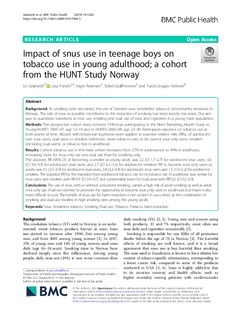| dc.contributor.author | Grøtvedt, Liv | |
| dc.contributor.author | Forsén, Lisa | |
| dc.contributor.author | Ariansen, Inger | |
| dc.contributor.author | Graff-Iversen, Sidsel | |
| dc.contributor.author | Holmen, Turid Lingaas | |
| dc.date.accessioned | 2019-12-06T09:26:43Z | |
| dc.date.available | 2019-12-06T09:26:43Z | |
| dc.date.created | 2019-10-30T10:52:09Z | |
| dc.date.issued | 2019 | |
| dc.identifier.citation | BMC Public Health. 2019, 19 . | nb_NO |
| dc.identifier.issn | 1471-2458 | |
| dc.identifier.uri | http://hdl.handle.net/11250/2632120 | |
| dc.description.abstract | Background
As smoking rates decreased, the use of Swedish snus (smokeless tobacco) concordantly increased in Norway. The role of snus as possible contributor to the reduction of smoking has been widely discussed. Our aim was to quantitate transitions in snus use, smoking and dual use of snus and cigarettes in a young male population.
Methods
This prospective cohort study includes 1346 boys participating in the Nord-Trøndelag Health Study in Young-HUNT1 1995–97, age 13–19 and in HUNT3 2006–08, age 23–30. Participants reported on tobacco use at both points of time. Models with binominal regression were applied to examine relative risks (RRs), of adolescent ever snus users, dual users or smokers (reference: never tobacco use), to be current snus only users, smokers (including dual users), or tobacco free in adulthood.
Results
Current tobacco use in this male cohort increased from 27% in adolescence to 49% in adulthood, increasing more for snus only use and dual use than for smoking only.
The adjusted RR (95% CI) of becoming a smoker as young adult, was 2.2 (CI 1.7–2.7) for adolescent snus users, 3.6 (CI 3.0–4.3) for adolescent dual users, and 2.7 (CI 2.2–3.3) for adolescent smokers. RR to become snus only users as adults was 3.1 (2.5–3.9) for adolescent dual users, 2.8 (2.2–3.4) for adolescent snus users and 1.5 (1.0–2.2) for adolescent smokers. The adjusted RR for the transition from adolescent tobacco use to no tobacco use in adulthood was similar for snus users and smokers with RR 0.5 (CI 0.4–0.7), but considerably lower for dual users with RR 0.2 (CI 0.2–0.3).
Conclusions
The use of snus, with or without concurrent smoking, carried a high risk of adult smoking as well as adult snus only use. Dual use seemed to promote the opportunity to become snus only users in adulthood, but made it also more difficult to quit. The benefit of snus use for harm reduction is not evident in our cohort, as the combination of smoking and dual use resulted in high smoking rates among the young adults. | nb_NO |
| dc.language.iso | eng | nb_NO |
| dc.publisher | BioMed Central | nb_NO |
| dc.rights | Navngivelse 4.0 Internasjonal | * |
| dc.rights.uri | http://creativecommons.org/licenses/by/4.0/deed.no | * |
| dc.title | Impact of snus use in teenage boys on tobacco use in young adulthood; a cohort from the HUNT Study Norway | nb_NO |
| dc.type | Journal article | nb_NO |
| dc.type | Peer reviewed | nb_NO |
| dc.description.version | publishedVersion | nb_NO |
| dc.source.pagenumber | 10 | nb_NO |
| dc.source.volume | 19 | nb_NO |
| dc.source.journal | BMC Public Health | nb_NO |
| dc.identifier.doi | 10.1186/s12889-019-7584-5 | |
| dc.identifier.cristin | 1742081 | |
| dc.description.localcode | Open Access This article is distributed under the terms of the Creative Commons Attribution 4.0 International License (http://creativecommons.org/licenses/by/4.0/), which permits unrestricted use, distribution, and reproduction in any medium, provided you give appropriate credit to the original author(s) and the source, provide a link to the Creative Commons license, and indicate if changes were made. The Creative Commons Public Domain Dedication waiver (http://creativecommons.org/publicdomain/zero/1.0/) applies to the data made available in this article, unless otherwise stated. | nb_NO |
| cristin.unitcode | 194,65,20,15 | |
| cristin.unitname | Helseundersøkelsen i Nord-Trøndelag | |
| cristin.ispublished | true | |
| cristin.fulltext | original | |
| cristin.qualitycode | 1 | |

